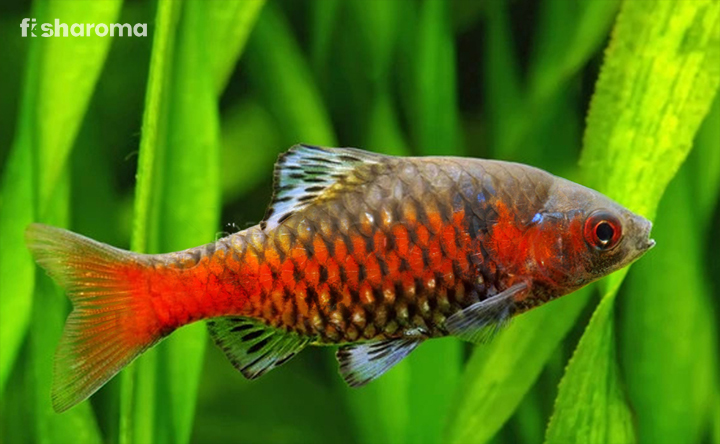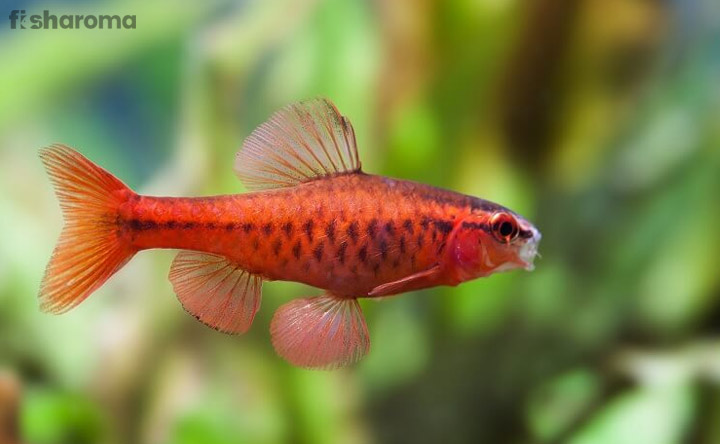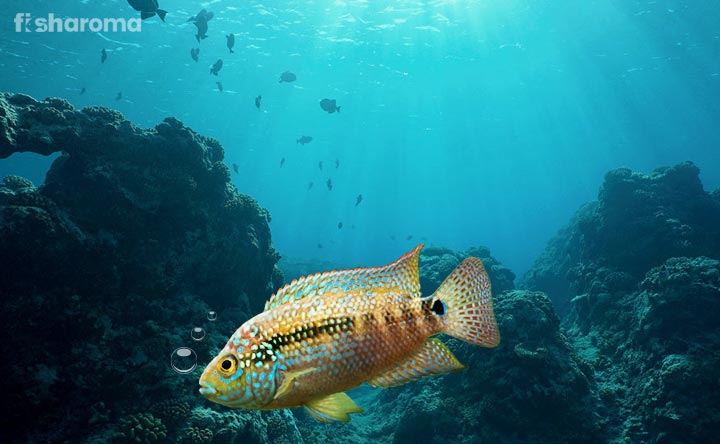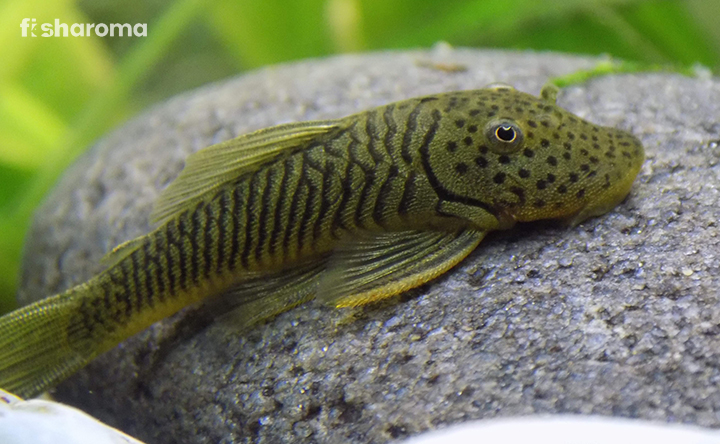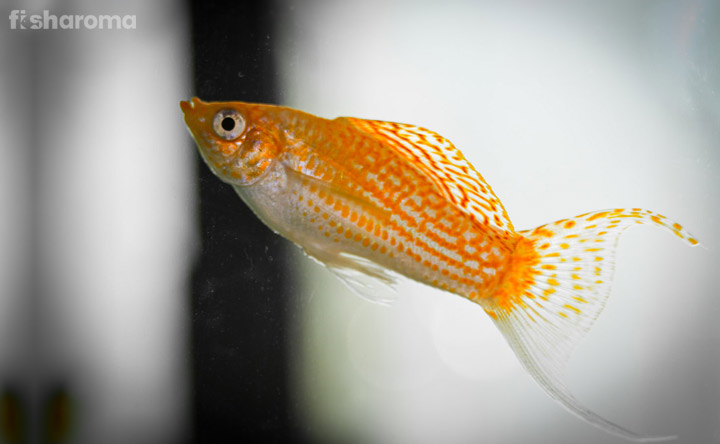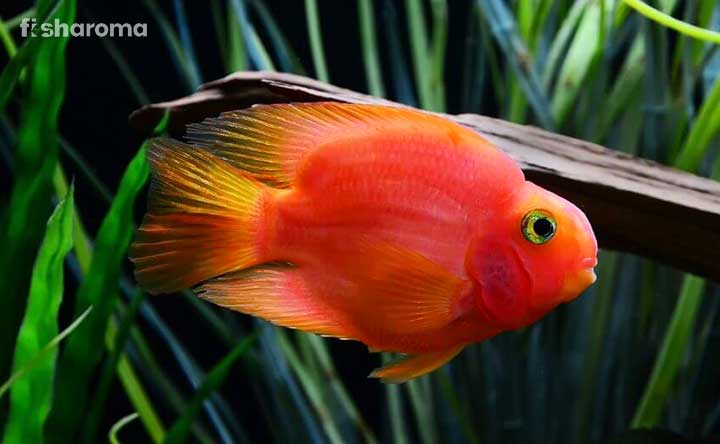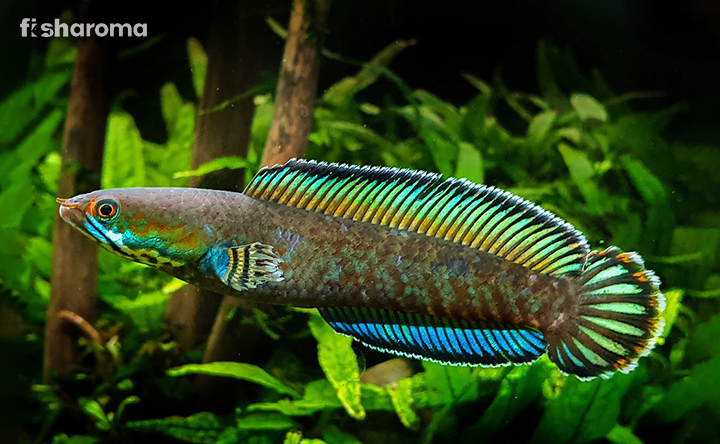Kuhli Loach Complete Care Guide – The Leopard-Skinned Fish
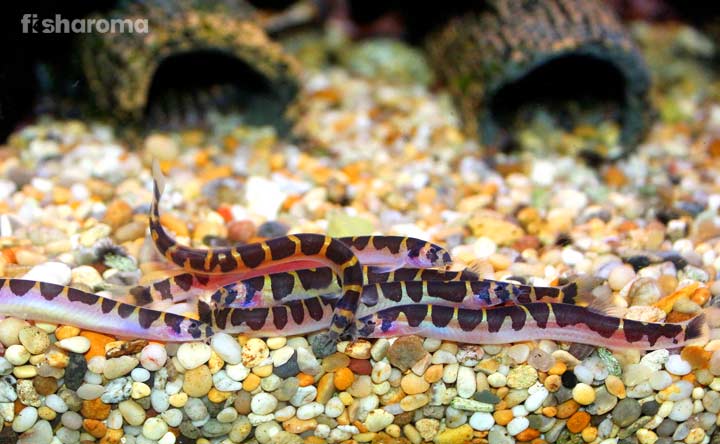
- Origin & Habitat of Kuhli Loach
- Appearance of Kuhli Loach
- Behaviour of Kuhli Loach
- Lifespan of Kuhli Loach
- Diet of Kuhli Loach
- Tank Requirements for Kuhli Loach
- Water Type for Kuhli Loach
- Introducing Kuhli Loach to the Tank
- Compatibility of Kuhli Loach
- Breeding of Kuhli Loach
- Kuhli Loach Diseases
- Summary
Providing a perfect blend of unorthodox appearance and a tank cleaner, Kuhli Loach has climbed its way to become one of the most highly sought-after aquatic pets. Getting to know it up and close will help you realize why its popularity is rising slowly and steadily. This is why we are providing you a constructive care guide for this freshwater avatar. So, without any further ado, let’s dig deep into it.
Key Specifications of Kuhli Loach
Before we breakdown each aspect of its care guide, let’s take a look at some of its key specifications.
| Scientific Name | Pangio kuhlii |
| Family | Cobitidae |
| Origin | Southeast Asia |
| Size | 3-4” (7-10 cm) |
| Color | Yellow with brown bands |
| Care Level | Intermediate |
| Lifespan | 10 Years |
| Temperament | Peaceful |
| Compatibility | High |
| Tank Size | 20 Gallons |
| Diet | Omnivore |
Overview
Members of the Cobitidae family, Kuhli Loaches or Pangio kuhlii as they are scientifically called, are peaceful nocturnal creatures. They are highly sensitive and have a flair to themselves that is fascinating to watch.
Since they are always on the move, they create quite a visual spectacle, thereby ensuring that there is never a dull moment in your tank. They were first discovered in the year 1846 by the Valenciennes.
They are also known by a bunch of other names including Cinnamon Loach, Prickly Eye, Leopard Loach, and Coolie Loach, among others. Their tendency to pull off an all-nighter (since they are nocturnal species) has earned them the distinction of being referred to as the owls of water.
Origin & Habitat of Kuhli Loach
Originating from Southeast Asia, Kuhli Loaches are freshwater species that are native to the streams of Java, Borneo, Malaysia, Sumatra, Singapore, India, and Thailand. In the wild, they are seen inhabiting the sandy beds of slow-moving rivers and the clean streams of forests and mountains.
Their habitat is similar to the old peat swamps of blackwater. Covered in thick vegetation and shaded by tree canopies, direct sunlight doesn’t go through the water they live in.
Appearance of Kuhli Loach
Shaped like an Eel, their appearance is unlike your average aquarium fish. This is why they are highly in demand by those who prefer keeping unorthodoxly-shaped aquatic pets.
One of the most interesting features about Kuhli Loach is their faint body scales and the lack of scales on their heads. This feature also makes them highly vulnerable to various diseases though.
Their slender bodies don’t have any distinguishable lateral line and their fins are too small to be seen. The anal and dorsal fins are close to each other and are almost on the same line. Their mouth is pointed downwards and is surrounded by four pairs of barbels. This feature helps them scavenging food from the substrate of your tank and in navigating their environment.
They protect themselves from their predators through sharp spines that are located below their eyes. It makes it quite difficult for their predators to swallow them or owners to net them because of the same reason.
Speaking of sexual dimorphism, the pectoral fins are larger in males than females. In addition, males also have more muscular dorsal cross-section than their female counterparts. However, at the time of breeding, females become larger.
Size of Kuhli Loach
Sized very much like a large worm, Kuhli Loaches grow up to 3-4” (7-10 cm) in captivity and 5” (12 cm) in the wild. They are among the smaller aquatic pets that one can have.
Color of Kuhli Loach
The color and markings play a big role in making Kuhli Loaches fascinating to look at. Reminiscent of the leopard marks, they have a pale pinkish-yellow body marked by 12-17 dark brown bands with three bands on their heads alone.
The underside of their body is much lighter than the top part. Their eyes are covered with transparent skin and there is a short spine in front of them.
There is a version of this species that is completely black or brown in color, which is called Black Kuhli Loach or Chocolate Kuhli Loach. An albino version of Kuhli Loach also has been bred in captivity, although it is not certain whether it exists in the wild or not.
Behavior of Kuhli Loach
Peaceful and shy by temperament, they spend a lot of their time hiding. As mentioned above, they are a nocturnal being that stays quiet during the daytime and becomes active at night. Also, they are easy to get scared and excited by the smallest of water movements.
They are highly curious and are prolific diggers and you will often see them burrowing into the sand. In addition, they are demersal fish, meaning they spend the majority of their time at the bottom of the water body. Whether it’s the river bed in the wild or the substrate in your tank, you will spot them at the bottom, scavenging for food.
Lifespan of Kuhli Loach
Kuhli Loaches are highly recommended for people who are ready for a long-term commitment towards their aquatic pets. Their average lifespan in captivity is 10 years, although they can live even longer, up to 14 years, in the wild.
Diet of Kuhli Loach
Being the omnivore species that they are, Kuhli Loaches eat anything and everything that you will serve on a platter. From crustaceans to larvae, from live to frozen food, they will eat them all.
They can be often seen sieving through a mouthful of substrates in search of food. They have an intriguing eating habit wherein they will wait for the food to sink at the bottom of the tank and then search for it. So, despite not being active hunters, they are skilled scavengers.
The only problem that you may face while feeding them is their nocturnal status. So, you either have to feed them at night or you have to make them change their schedule. Now, you have to practice patience here since it might take them weeks to adjust to daytime feeding.
They also readily accept flakes, wafers, tablets, and pellets, which extends the range of the food you can offer them. Ideally, they prefer meat-based food, but don’t forget to provide diversity in the food you give them.
The diet of a Kuhli Loach should comprise of the following:
- Bloodworm
- Grindal Worm
- Daphnia
- Microworm
- Blackworm
- Brine Shrimp
- Tubifex
- Mosquito Larvae
- Blanched Cucumber, Peas, Spinach
- Plant Matter
Remember, you can feed the aforementioned food items both in live and frozen form.
Coming to artificial food, the Hikari Tropical Sinking Wafer is a great choice for them. There are many herbivore pellets and algae wafers available in the market for Loaches, which you can feed them as well.
We understand getting hold of live food is not always possible, but try to provide it at least 2-3 times a week to augment dry food. You may feed them several times a day; however, don’t overfeed them. When it comes to the young ones, you can feed them Infusoria.
Tank Requirements for Kuhli Loach
Coming to the tank setup, you need to keep in mind the following points to make your Kuhli Loach feel at home.
Tank Size
The small size of Kuhli Loach allows you to keep them in a small tank. A 20-gallon tank is ideal for a single Loach, and with each Loach you add to your tank, add in a space of 4 gallons.
Remember, the floor space is more important for them than the volume of water since they are a bottom-dwelling species. Thus, adding 4 gallons of water with each Loach won’t cut the deal. You have to increase the size of the tank. In other words, go for a long rectangular tank.
Filter
In order to reduce waste from the tank and to keep the water well-oxygenated, we recommend you to use an under gravel filter. However, you can also go for a hang-on-back or canister filter although the latter is too expensive. Basically, look for a filter that provides a turnover of a minimum ten times per hour.
No matter which filter you pick, make sure it has a covered intake since incidents of Kuhli Loaches swimming up the uncovered filter intakes and trapping themselves to death is pretty common. So, set this as your priority when setting up your tank.
Tank Lid
Kuhli Loaches are notorious jumpers. So, if you don’t want to see them jump out of the tank to an untimely death, use a firm tank lid.
Nature of Lighting
They don’t get access to direct sunlight in their natural habitat. Therefore, try to reflect the same in their aquarium as well. A low to moderate light setting is advised for them.
Presence of Flora
They prefer thick and dense vegetation. Plants serve as hiding spots in addition to dimming the lights. So, play around with aquatic plants in a Kuhli Loach tank.
Java Fern and Cryptocoryne are suitable plants for them. Don’t forget to regularly trim them in order for stopping them from turning wild. If you want to take a step further, you can replicate leaf litters by spreading peat moss inside their tank.
Although we advise using live plants, you can also resort to artificial ones (as long as they are not made of toxic materials/colors/fragrance) if you don’t want to deal with the hassles of rearing a live one.
Keeping floating plants at the time of breeding is highly recommended.
Ornaments
Similar to plants, go creative in your choice of ornaments since they would act as additional hiding spots for your Loach. Just ensure that they don’t have any sharp edges to them. From caves to driftwood, twigs to rocks, you can virtually use anything.
Remember, an exposed space with no place to hide will stress them out. The need for these hiding spots is even more in a community tank since they would serve as a nice place for retreat when they feel threatened. Having said that, don’t overcrowd the tank.
If you are keeping any caves or castles in the tank that have holes in them, make sure they are wide enough so that your Loach doesn’t get stuck in them.
Substrate
Kuhli Loaches frequently search through the substrate in search of food, which is why you need to make sure that the substrate is soft and smooth enough.
In the wild, the river bed’s substrate can vary from mud to sand to even peat. Thus, a mix of sand and fine gravel (without any sharp edges) is pretty ideal for your aquarium.
Cleaning Method
Make sure the substrate, ornaments and the interior walls of your tank are clean and don’t have any residue on them. Use lukewarm plain water for cleaning purposes and avoid using chemicals or soap-based products since they may have adverse effects on the health of your Loaches.
You can simply put the ornaments under running water to clean them. When it comes to the substrate, you can suction/vacuum it to remove the excess waste and food. However, don’t remove any biofilm on the décor and rocks. Although not mandatory, you may use a magnet algae cleaner to keep the viewing pane clear.
Water Type for Kuhli Loach
The next phase that you need to put your attention into is the water type for this peace-loving fish. Let’s find out the key water requirements for them.
Temperature
Since they are a tropical species, keep the temperature of the water fairly warm between 73-86° F (22-30° C).
pH Level
Kuhli Loaches prefer slightly acidic water. Thus, make sure the pH level of your water is 5.5-6.5.
Hardness
Go for a soft water with a general hardness of 0-5 dGH.
Replacement Procedure
Just like any other Loach, a Kuhli Loach is infamous for making the tank water dirty. Therefore, regular replacement of the water is of utmost importance. Ideally, we recommend maintaining a fixed water replacement schedule. This means replacing a fixed percentage of the tank water at a fixed time interval.
For instance, if you are planning to do it on a weekly basis, then replace 10% of the tank water; else if you want to do it every 15 days, then replace 25% of the tank water. If you are a busybody and can only allot one day in a month to do this, then replace 40% of the water.
The new batch and the existing batch of the tank water must have a similar temperature, pH level, and water hardness. Never replace all of the water at once since it will kill off the beneficial bacteria in your tank altogether.
Introducing Kuhli Loach to the Tank
It is extremely important to let them acclimatize with the new tank water. Throwing them into a new tank can lead to “new tank syndrome” in them that may cause various diseases. You have to be slow and steady with the process of introducing them to your tank for the first time.
Start by putting the bag that they came in into the tank for 30 minutes. When the bag will float in the tank, the Loaches inside will get used to the temperature of the tank water.
After 30 minutes, replace 10% of the water from the bag with tank water and wait for an additional 20 minutes. Continue doing this four more times up until the composition of your bag has 50% original water and 50% tank water. Next, gently release the fish into the tank. Following this process will help your Loach get used to the chemical condition of your tank.
Compatibility of Kuhli Loach
When kept alone in a tank, a Kuhli Loach will seldom come out and spend the majority of its time hiding. So, despite it not being a schooling fish, we recommend you to keep it in groups of at least 5-6. Keeping them with their own kind will help them be more active. They also function well in community tanks.
Suitable Tankmates for Kuhli Loach
Kuhli Loaches are pretty compatible with other small, peaceful species. Choosing a tankmate for them won’t give you much trouble. Since they spend the majority of their time at the bottom of the tank, you can pick pelagic species (species that stay in the mid-portion of the water) for them.
Ideal tankmates for Kuhli Loaches are as follows:
- Black Tetra
- Neon Tetra
- Dwarf Gourami
- Honey Gourami
- Blue Gourami
- Pearl Danio
- Zebra Danio
- Apistogramma
- Discus
- Corydoras Catfish
- Otocinclus Catfish
- White Cloud Mountain Minnow
- Guppy
- Platy
- Rasbora
- Red Cherry Shrimp
When kept in a community tank, make sure they have plenty of hiding spots in the form of aquatic plants and ornaments.
Unsuitable Tankmates for Kuhli Loach
Avoid keeping your Kuhli Loaches with larger, aggressive, and territorial species since they will chase and bully your Loach. Also, keep nipping species away from them as well since they may harm your Loach. On the other hand, invertebrates such as Snails must be kept away as well since your Loach may eat them by considering them as food.
The species that are deemed as unsuitable tankmates for Kuhli Loach are as follows:
- Red Tail Shark
- Betta
- Blue Gourami
- Arowana
- Cichlid
- Chinese Algae Eater
- Tiger Barb
- Angelfish
- Snail
Breeding of Kuhli Loach
Breeding Kuhli Loaches is extremely difficult and is seldom done by home aquarists. However, if you still want to go ahead, you need to maintain the following parameters and process.
It is recommended to use a separate breeding tank for them. Ensure that the water level is low in the tank and the lights are subdued. The pH level of the water must be 6.5. Use floating plants since females will lay their eggs on them. To facilitate spawning, we advise you to feed them live food.
This species is a communal spawner, meaning it spawns collectively with its own kind. Therefore, keeping it within a community of its own will increase its chances of spawning successfully. This means that instead of keeping a pair, you have to keep a bunch of them together. Ensure that your Loaches are at least two-years-old at the time you start this process.
As we said earlier, females tend to bulk up at this stage. When they are ready to spawn, the females release bright green eggs on the underside of the floating plants. We strongly advise removing the adults at this stage since they are notorious for eating the eggs.
The eggs usually hatch within 24 hours. You can feed Infusoria or freshly hatched Brine Shrimp to the fries. They start swimming on their in four days and in a month, they start forming the black stripes on their body.
Kuhli Loach Diseases
The biggest reason behind recommending Kuhli Loaches for experienced aquarists is because they are highly prone to diseases. The lack of scales on their bodies is the primary cause of this. What is worse is that they are sometimes even allergic to the medications that are used to treat their diseases, which makes them extremely difficult to pet.
Ich (Ichthyophthirius) is the most common form of the disease in aquatic pets and Loaches are one of the first ones to breakdown because of it. Also known as “White Spot Disease”, it is a parasitic disease marked by white spots on their bodies.
In addition, they also are prone to suffer from “Skinny disease”, which is another internal parasitic disease, which is marked by severe weight loss in them despite eating nutritious food.
Visiting a veterinary for their treatment instead of experimenting on your own is recommended. As a precautionary step, keep your tank environment healthy. This involves regular replacement of water and cleaning of tank materials. Keep feeding them nutritious food, while avoiding a situation of overfeeding and underfeeding.
Another major factor that helps keep your pet healthy is quarantining. It involves not only quarantining your pet, but also the substrate, the ornaments, the aquatic plants, and everything else that you put inside the tank since you never know what will be the germ-bearer.
Interesting Facts about Kuhli Loach
- Before spawning, the green ovaries of Kuhli Loach can be seen through their skin.
- They are known to play dead by lying on their side.
- They are known for forecasting weather since they can sense changes in atmospheric pressure which they react to by swimming crazily along the walls of the aquarium or simply by swimming in circles.
Summary
Kuhli Loaches are fascinating creatures. With their unorthodoxly-shaped body, peaceful demeanor, and curious nature, they are an absolute delight to watch. They also keep your tank clean by eating up leftover food and sometimes algae from the bottom of your tank. However, being sensitive species, they are highly vulnerable to a bunch of diseases. This is why they are recommended for experienced aquarists only.
Their longer lifespan requires a long-term commitment from your end. In addition, breeding them is virtually impossible since a number of factors have to align perfectly for the process to succeed. So, if you are ready for facing these issues and if your love for them is bigger than your fear of handling them, then go ahead and bring these adorable fish home.
Sneak Peek into the Care Guide of Other Freshwater Species
- Harlequin Rasbora – Named after the comic character Harlequin, these tiny pets will keep you captivated for hours with their schooling behavior.
- Cherry Barb – Enjoy these bright red angels as they roam around in your aquarium flaunting their adorable appearance.
- Molly – Turn your aquarium into a playground by including this brightly-colored beauty that is one of the most popular species of aquarium fish across the globe.

